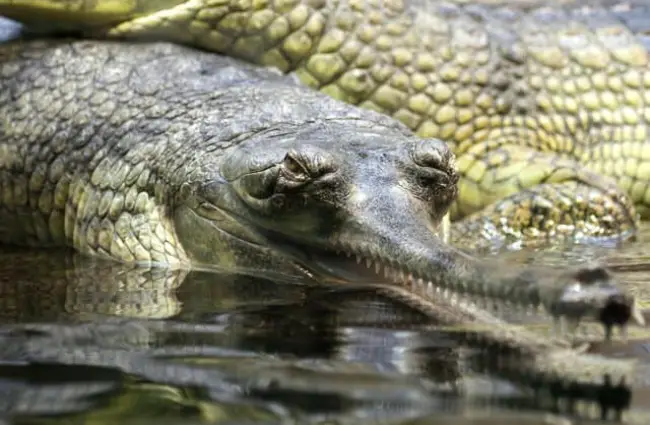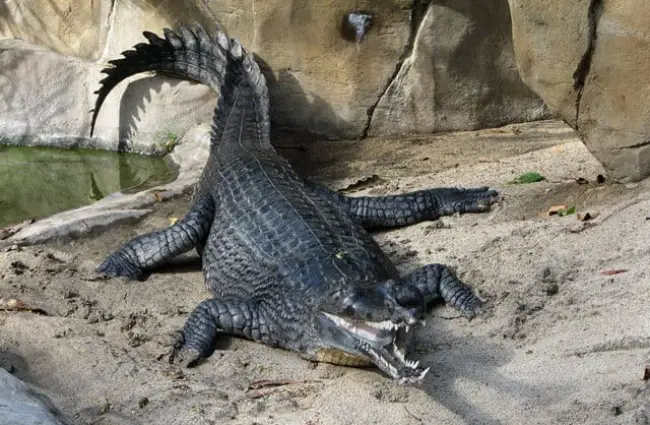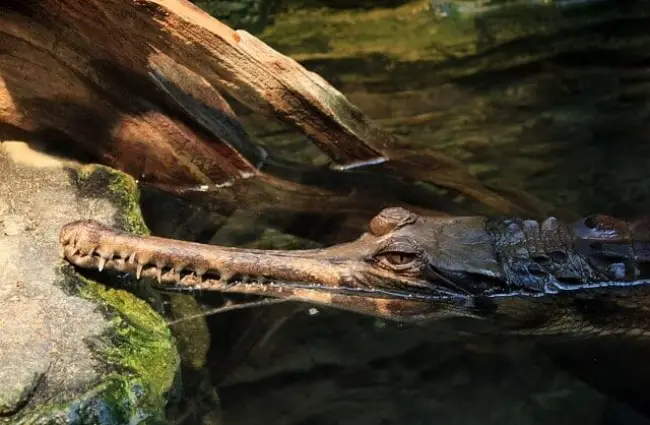Gharials are one of the largest members of the crocodilian family. They look very similar to crocodiles and alligators, but they have a distinctive long, narrow snout, which reduces water resistance and helps them to hunt for fish. Historically, they lived in only four river systems in the world, but have now become extinct in many areas. The gharial is now listed as a Critically Endangered species. Read on to learn about the gharial.
Description of the Gharial
Gharials have a typical crocodilian shape, other than their extremely elongated, narrow snouts. They are covered with smooth, non-overlapping scales. Adults are generally a dark or light-olive color, and youngsters usually have speckling and dark cross-bands on their heads, bodies, and tails. They have partly webbed fingers and toes. Like other crocodilians, they have a very thick, powerful tail, which is flattened on the sides (“laterally compressed”).
The male gharial has a large, hollow swelling at the end of his snout that is known as a “nasal boss.” This only develops when he becomes sexually mature. This swelling, and the males’ greater body-size, makes it easy to distinguish between male and female gharials (i.e. sexual dimorphism), something which is rare among other crocodilians. The function of the nasal boss is not well understood, but it might be a visual sex indicator, or it might be used as a sound resonator.
Interesting Facts About the Gharial
Gharials are different from other crocodilian species, as they eat almost only fish. To achieve this, they have several unusual and interesting adaptations.
- Hunting – It is believed gharials sometimes herd fish against the shore with their bodies, and then stun the fish by quickly snapping their jaws together – this is known as “percussive stunning.”
- Numerous Teeth – Gharials have 110 sharp, interlocking teeth in their incredibly long, narrow snouts.
- Population – It is estimated that there are now only 200 – 1,000 gharials in left the wild.
- Common Name – The large, distinctive swelling at the end of the snout resembles a type of local earthenware pot. In Hindi, these pots are called ghara, thereby giving the gharial its common name.
Habitat of the Gharial
Gharials generally prefer clear, flowing, freshwater rivers with deep pools and plenty of fish. They also like habitats with sand-banks or san-bars for nesting and basking in the sun.
Distribution of the Gharial
Gharials are found in small populations in only a few localities in the Northern part of the Indian Subcontinent.
Diet of the Gharial
Young gharials eat small fish, frogs, tadpoles, and insects. Adults also feed on larger fish and crustaceans. Gharials do not chew their prey, rather, they swallow it whole.
Gharial and Human Interaction
The gharial population has declined drastically in the past 60 years, and they are now listed as Critically Endangered. The reasons for this decline in the population size are the loss of suitable river habitats (due to dams, barrages, canals, and the like), depletion of the fish on which they feed, and becoming tangled in fishing nets.
Gharials have been killed by fishermen, hunted for their skins, and used as trophies, and in alternative medicine. Hunting is no longer considered to be a threat, though their eggs are sometimes collected as food.
Domestication
Gharials have not been domesticated.
Does the Gharial Make a Good Pet
Gharials are Critically Endangered, and should not be kept as pets.
Gharial Care
Due to the great rarity of gharials and their highly specialized requirements, only those people with expert knowledge and facilities should attempt to care for them.
Behavior of the Gharial
When hunting, their very narrow jaw allows gharials to catch rapidly moving fish by using an extremely quick, side-to-side snapping motion. Like other crocodilians, gharials are cold-blooded (ectothermic). They are most likely to be seen on land when they are basking on sand-banks or rocks, using the sun to warm themselves. They often bask in groups, but dominant individuals may defend a preferred spot.
Unlike other crocodilians, gharials have weak legs. When fully grown, they cannot raise their body above the ground on land and they have to move about by sliding on their bellies. However, once in the water, they are extremely agile.
Reproduction of the Gharial
Males become sexually mature at about 13 years of age, which is when their nasal boss develops. The males call for mates by swimming around their territory making hissing and buzzing noises, aided by the nasal boss. They might attract several mates and form a harem within their territory, which they aggressively defend from other males.
Gharials usually mate during December and January, and again in the dry season (March and April). They dig their nests using their hind feet, usually in a riverside sand-bank. The nests are approximately 20 – 24 in (50 – 60 cm) deep. The female lays 20 – 100 eggs, which are the largest of any crocodilian species, and take 71 – 93 days to incubate.
Female gharials dig up the young when they hear their hatching chirps, and guard the hatchlings for several days. They do not carry their young in their mouths like other crocodilians, presumably because of the sharpness of their teeth.











![Red Angus Closeup of a beautiful Red Angus cowPhoto by: U.S. Department of Agriculture [pubic domain]https://creativecommons.org/licenses/by/2.0/](https://animals.net/wp-content/uploads/2020/03/Red-Angus-4-238x178.jpg)












![Red Angus Closeup of a beautiful Red Angus cowPhoto by: U.S. Department of Agriculture [pubic domain]https://creativecommons.org/licenses/by/2.0/](https://animals.net/wp-content/uploads/2020/03/Red-Angus-4-100x75.jpg)

